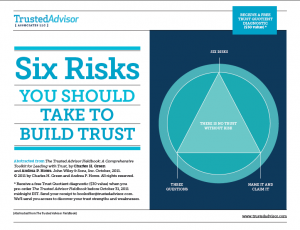Why We Don’t Trust Companies, Part III – Risk
 This is the third in a four-part series about why we don’t trust companies. The final post will offer solutions.
This is the third in a four-part series about why we don’t trust companies. The final post will offer solutions.
In the first and second posts, I said trust in companies is so low because companies don’t understand the personal nature of trust, and because they hold various beliefs that seem at odds with trust. Call those drivers “ignorance” and “ideology.”
[Note: ignorance and ideology are not the reasons commonly cited for low corporate trust. The usual suspects include lack of regulation, conflict of interest, perverse incentives, lax enforcement, and greed].
There is one more big issue that affects our distrust of companies – the issue of risk. Risk is fundamental to both corporations and to human trust, but their views on the subject are diametrically opposed.
Trust absolutely requires risk, while corporations abhor it. The conflict between these two views explains quite a bit.
Risk and Trust
There simply is no trust without risk, almost by definition. To trust another is to willfully put oneself in harm’s way. The act of trusting lies somewhere between one extreme of cold calculation of odds, and the other extreme of blind faith.
Contrary to what Ronald Reagan was fond of saying, “trust but verify” is an oxymoron. If you have to verify, it isn’t trust; and the act of verification tends to negate trust.
Risk plays a critical role between the two parties of a trust relationship. The trustor is the one taking the risk, the one who puts himself in harm’s way. The trustee is the one who is granted the power by virtue of the trustor’s risk. How he responds is critical to the establishment of trust.
This dance of risk-taking is the essence of human relationships. I extend my hand, and you either extend yours back to me, or turn on your heel and spurn me. Romantic relationships are established by an elaborate ritual of progressive risk-taking and positive responses. So it is with trust.
Trust is a bilateral, asymmetric relationship – risk is the medium of exchange. A trusting relationship can mitigate larger risks, but it almost always begins with a small risk taken.
Risk and Companies
By contrast, corporations abhor risk. In a zero-sum, Hobbesian, sustainable-competitive-advantage world (see part II of this series), to put oneself in harm’s way of another is simply irrational, if not suicidal.
[Note: I’m not talking here about risk in financial markets – alpha and beta, hedging, risk appetite – those are design features of a product being sold.]
This negative attitude toward risk is pervasive. It’s at the root of business insurance contracts, legal reviews, communications approval processes, and a great many policies and procedures.
I recently heard of someone in the reputation management business who said they’d gotten inquiries from people and from companies alike in times of crisis. But, when they heard that his recommendations included an apology, all the corporate inquiries dropped off. Only individuals were willing to consider reputation repair that included apologies.
The reason is clear: to apologize looks like an admission of guilt. An admission of guilt opens up a corporation to civil lawsuits. Almost all companies will view such a situation in strictly legal terms, and the “right” answer is the one that limits risks. Ergo, no apology.
This dichotomy makes sense because humans relate to apologies – to apologize is a form of risk-taking that can help restore trust. Corporations, not being human (see Part I), see apologizing in strictly legal, non-human terms. For people, apologies are about character and reputation; for corporations, they’re about threats and survival.
We as humans want truth-telling and accountability in order to trust. But companies tend to resist telling the truth or taking accountability if it puts them legally at risk.
When you have different perspectives on truth and accountability, you have a very wide divide. One more reason we don’t trust companies – they don’t usually behave by the “rules” of trust, which is (see Part I) predominantly human.
==========
The final part in this series will move from the negative to the positive, and offer solutions.

 Our Story Time series brings you real, personal examples from business life that shed light on ways to lead with trust. Our last story illustrated
Our Story Time series brings you real, personal examples from business life that shed light on ways to lead with trust. Our last story illustrated  We’re pleased to announce the release of our latest eBook:
We’re pleased to announce the release of our latest eBook: